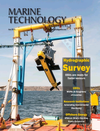
Page 21: of Marine Technology Magazine (June 2019)
Hydrographic Survey: Single & Multibeam Sonar
Read this page in Pdf, Flash or Html5 edition of June 2019 Marine Technology Magazine
he list of applicants to en- docking station for the AUV, you’re ter the underwater domain not reliant on a docking station on the
CONTROL is growing fast. The con- seabed and you don’t need a larger sur- cepts vary, from underwa- face vessel.”
Tter autonomous mother- The system includes a submersible ships able to carry an array of payloads towing head, with an inductive con- over long distances to swarms of drop nector for charging and data transfer, deployed ocean bottom nodes that can which acts a little like an in-air refuel-
POWER
REACTION ? nd their way to pre-programmed lo- ling of ? ghter jets. “This means there’s cations. minimal impact from waves because
At energy:connected, as the Oslo- the docking is at a controlled depth,” based Subsea Valley cluster and an- says Lima, who has an MSc in Sub- nual conference is now called, some of sea Engineering from University of these concepts were outlined, includ- Aberdeen and a MSc in Innovation ing those from two Norwegian tech- and Entrepreneurship from University nology ? rms and Germany’s thyssen- of Oslo. There’s also a through moon krupp, a ? rm more used to designing pool-based handling system for recov- naval submarine systems. ering the AUV on deck, safely.
The system will support subsea sur- uSEA unveils uLARS vey in shallow waters as well as in
Motion
One, Norwegian technology start-up deep and ultra-deep waters, operating uSEA, is proposing a hybrid system a wide variety of payloads ranging to disrupt existing manned vessel sup- from more conventional types such as
Evolution ported subsea operations via a subsea side-scan sonar and multibeam echo- and surface drone combination. sounders to more advanced such as
It takes superior senses to thrive uSEA was founded in 2017 and since synthetic aperture sonar.
in the marine world. We’re then it has been developing a surface uSEA is looking for partners to com- constantly evolving with cutting drone, or unmanned surface vessel plete the quali? cation programme, edge research and development, (USV), to support underwater drones which is expected by the end of next bringing inertial sensing products (i.e. autonomous underwater vehicles year (2020). After that, the company is or AUVs), so that manned vessels are targeting operations in the sea and it’s to your marine application.
no longer needed and battery recharg- looking for pilot projects to perform in ing can be done in the water, avoid- 2021.
FOG GRADE PERFORMANCE ing launch and recovery operations.
COMPACT, ROBUST
This makes it different to other surface An iDROP in the ocean
AND RELIABLE drone concepts, which tend to rely on Another Norwegian technology ? rm, full recovery of the AUV or remote iDROP, is planning to disrupt the sea-
QUALITY TECHNICAL SUPPORT operated vehicle (ROV) for recharg- bed seismic technology market with its
DURING INTEGRATION ing. uSEA’s system is called uLARS autonomous Oceanid nodes. iDROP’s
COST-EFFECTIVE (LARS meaning launch and recovery system is based on individual cylindri-
NAVIGATION CORE system) for underwater drones, says cal sensor nodes (named after Greek uSEA CEO Felipe Lima, who served sea nymphs) that are dropfall de-
IDEAL WHERE in the Brazilian Navy before working ployed, using gravity and ballast shift
SPACE IS AT A at Subsea 7, Aker Solutions and Xodus for propulsion and position control, to
PREMIUM
Group. land at speci? c pre-planned positions
It’s a natural progression. Today’s on the seabed where they land on alu- www.siliconsensing.com
AUVs are getting more and more ca- minium legs which pop out before they pable and reliable, says Lima. “They land. #motionevolution are taking the space that has been the The idea is that they can be deployed backyard of ROVs. But, they have a in groups, falling to form grid patterns limitation; they rely on batteries, be- on the seabed for seismic surveys. On- cause they’re not cabled like ROVs, board batteries power the descent con- and they still need a mothership, eg. a trol (using just 5% of the battery doing survey vessel, because their batteries so), data harvesting (for 180 days) and run out in 12-48 hours. With a mobile trigger a mechanism that releases the www.marinetechnologynews.com
MTR #5 (18-33).indd 21 5/24/2019 11:55:16 AM

 20
20

 22
22
